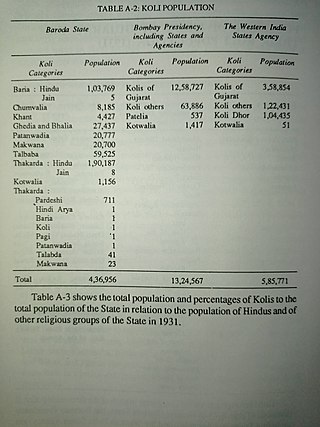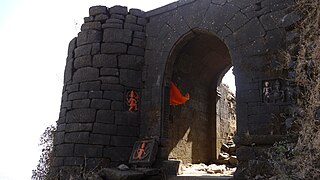Many parts of Western and Northern regions of the Indian subcontinent were ruled as sovereign or princely states by various clans of Kolis.
Contents

Many parts of Western and Northern regions of the Indian subcontinent were ruled as sovereign or princely states by various clans of Kolis.




The Maratha Empire, also referred to as the Maratha Confederacy, was an early modern Indian empire and later a confederation that controlled large portions of the Indian subcontinent in the 18th century. Maratha rule formally began in 1674 with the coronation of Shivaji of the Bhonsle dynasty as the Chhatrapati. Although Shivaji came from the Maratha caste, the Maratha empire also included warriors, administrators, and other nobles from the Maratha and several other castes from what is known today as Maharashtra. The Maratha Kingdom was expanded into a full-fledged Empire in the 18th Century CE under the leadership of Peshwa Bajirao I.
Patel is an Indian surname or title, predominantly found in the state of Gujarat, representing the community of land-owning farmers and later businessmen, agriculturalists and merchants. Traditionally the title is a status name referring to the village chieftains during medieval times, and was later retained as successive generations stemmed out into communities of landowners. There are roughly 500,000 Patels outside India, including about 150,000 in the United Kingdom and about 150,000 in the United States. Nearly 1 in 10 people of Indian origin in the US is a Patel.

Sinhagad is an ancient hill fortress located at around 49 km southwest of the city of Pune, India.
The Nayak, or Naik is a historic Indian title conferred on military generals and governors of feudal states in the Middle Ages. Today it is also a surname. Nayaks are mostly Hindu and few Sikhs, who follow Hinduism and Sikhism respectively.

Koli Christians are subgroup of the Koli people, known as Bombay East Indians, the indigenous people of the Seven Islands of Bombay and the Bombay metro area, which is now also called Mumbai (Bombay). The Koli Christians were of the Son Koli caste, before their conversion by the Portuguese from Brahmanism to Christianity, in the former Bom Bahia of Portuguese India. Christian Kolis are also known as Thankar and Gaonkar Kolis in Maharashtra, where they played an important role in building churches and convents in the northern Konkan division of Maharashtra.
Bhoite is a surname found amongst the Maratha caste, mainly in the state of Maharashtra in India but it also appears in Indian states bordering Maharashtra.
Dabhade surname signifies Maratha and Koli clans found largely in Maharashtra, India. The Maratha Dabhades were originally centered on Talegaon Dabhade, but became the chiefs of Gujarat. They held the hereditary title of Senapati (commander-in-chief) and several jagirs in Gujarat until 1751. That year, Umabai Dabhade and her relatives were arrested for a rebellion against the Peshwa, and were stripped of their titles.
The Jadhav is an clan (Gotra) found in the several castes such as Koli, Maratha, Banjara and Mangs living in Indian states of Maharashtra, Goa, Karnataka, Telangana
Harpale (हरपळे) is a surname used by Indian Maratha community. The name is legendary among Maratha Royalties. They were honoured as Sardar, Patil and Deshmukh. They have a Royal Mark of Gaikwad Maharajas of Baroda. They possess Deshmukh rights of villages in Nagpur. Their relations are associated with the prominent Maratha clan of 96 Royal Clans.
The Malhar also known as Panbhare is a Subcaste of the Koli caste found in the Indian states of Gujarat, Maharashtra, Goa and Karnataka. The Malhar Kolis used to work as Yeskar and they were Subedar or fortkeeper of Sinhagad, Torna and Rajgad forts during time of Shivaji. Their local traditional dance is Tarpa Dance in Maharashtra. they worship the Waghowa devi which is a lion goddess.
The Kotwal also spelled as Cotwal, or Kotval was a title used in medieval and early modern India for the leader of a Kot or fort. Kotwals often controlled the fort of a major town or an area of smaller towns on behalf of another ruler. It was similar in function to a British Indian Zaildar From Mughal times the title was given to the local ruler of a large town and the surrounding area. However, the title is also used for leaders in small villages as well. Kotwal has also been translated as Chief police officer. The post of Kotwal was known since ancient times as Kota pala who was the chief of Police.

Baria, or Baraiya,Bareeya and Bariya is a clan (Gotra) of the Koli caste found in the Indian State of Gujarat and Dadra and Nagar Haveli and Daman and Diu. the Devgad Baria was their Stronghold or given their name to Baria State in Gujarat. according to the historian Y.V.S Nath, the ruling royal family of Baria State is original Koli by caste but later they claimed to be of Rajput origin to be in high status among other Princely States.
The Bavan Maval, or Bawan Mawal was a territory of fifty two valleys and forts ruled or controlled by Koli chieftain during Maratha Empire. All these forts mostly came in the districts of Pune and Ahmednagar and each fort had a hereditary Koli Nayak or Sardar, due to which the Kolis were known as Mavala.

The Raghojirao Ramjirao Bhangre also spell Bhangaria was an Indian revolutionary who challenged and defied the British power in Maharashtra. He was the son of Ramji Bhangare, a Koli who also resisted the British rule and was subsequently hanged in Cellular Jail. He was only ten years old when he took up arms against British rule in Maharashtra.
Khemirao Sarnaik was a Koli Deshmukh of the Maval region in 1640s, rebelled against Mughal governor Aurangzeb and abolished Jizya.

Naik Govind Rao Khare was the Subedar of the hill fort Ratangarh under Peshwa government in the Maratha Empire. He was born in a farming family of Maharashtra. Khare was a revolutionary of the Indian independence movement who took up arms against the British rule in Maharashtra and declared the end of British rule. he was chief of the Kolis of Khare (Khade) clan and belong to the Mahadev koli family and led the rebellion from 1819 to 1830. his family was chief of the four villages and was tributary to peshwa and enjoying the Deshmukhi.

Laya Patil, also spelled as Lai Patil, was the leader of a naval unit of the Maratha Navy of the Maratha Empire at the time of Chhatrapati Shivaji Bhonsle. He was a Koli by caste and born in Alibag, present-day Maharashtra. Shivaji had built a warship in the honor of Laya Patil, which was named Palkhi and honoured with the title of Sarpatil.
Bapuji Bhangare was a Koli Patil of Deogaon and Indian freedom fighter who challenged the British government in Maharashtra state of British India. Bapuji Bhangare breakdown the British government strongly in Pune, Ahmadnagar and Nashik districts of Maharashtra.
The Son Koli, or Sona Koli is a subcaste of the Koli caste found in the Indian state of Maharashtra. The Son Kolis are the original residents of what is now Mumbai, the capital of Maharashtra. They practice both Hinduism and Christianity because Son Kolis were converted to Christianity during the Portuguese rule in India and worship Our Lady of Mount and Hindu deities. Historically, the Son Kolis have been fisherman by profession.
{{cite book}}: CS1 maint: date and year (link){{cite book}}: CS1 maint: location (link){{cite book}}: CS1 maint: location missing publisher (link)